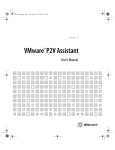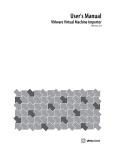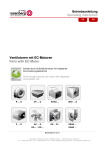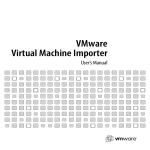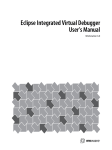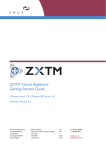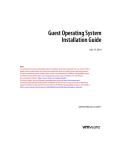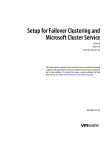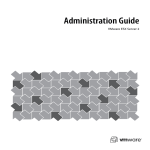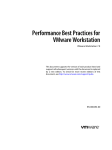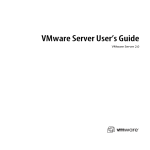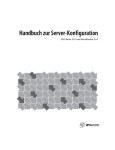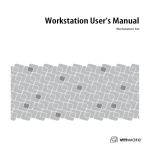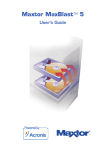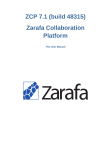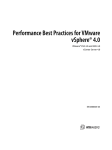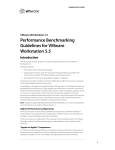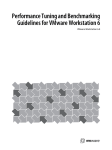Download VMware® P2V Assistant
Transcript
VERSION 2.0 VMware® P2V Assistant User’s Manual VSC 1004 IPR of U.S. Pat. No. 7,480,822 Please note that you will always find the most up-to-date technical documentation on our Web site at http://www.vmware.com/support/. VMware, Inc. The VMware Web site also provides the latest product updates. 3145 Porter Drive Palo Alto, CA 94304 www.vmware.com Copyright © 1998-2004 VMware, Inc. All rights reserved. Protected by one or more of U.S. Patent Nos. 6,397,242, 6,496,847, 6,704,925, 6,711,672, 6,725,289 and 6,735,601; patents pending. VMware is a registered trademark and the VMware boxes logo, GSX Server, ESX Server, Virtual SMP and VMotion are trademarks of VMware, Inc. Microsoft, Windows, and Windows NT are registered trademarks of Microsoft Corporation. Linux is a registered trademark of Linus Torvalds. All other marks and names mentioned herein may be trademarks of their respective companies. Revision 20040622 Item: P2V-ENG-Q204-001 Table of Contents Introducing VMware P2V Assistant ________________________________7 Cloning for GSX Server and Workstation ______________________________10 Creating a Cloned Disk using a Third Party Image ____________________10 Creating a Cloned Disk using the P2V Assistant ______________________11 Reconfiguring an Existing Cloned Disk into a Bootable Disk ____________13 Clones for ESX Server ____________________________________________14 Create a VMware ESX Server Cloned Disk Using the Direct to Disk Device Mode ______________________________________________________14 Reconfigure an Existing ESX Server Cloned Disk into a Bootable Disk _____16 Convert a Third Party Image to an ESX Server Formatted Cloned Disk ____17 Convert a .vmdk Disk File to VMware ESX Server Format _______________18 Using the Cloned Disk in a Virtual Machine ___________________________19 About the New Virtual Machine __________________________________19 Application Compatibility _________________________________________21 About This Manual ______________________________________________22 Intended Audience ___________________________________________22 Additional Resources __________________________________________22 Document History ____________________________________________22 VMware P2V Assistant Requirements and Resources ________________ 23 What’s New in Version 2.0? ________________________________________24 P2V Assistant Requirements _______________________________________25 VMware P2V Assistant Helper Machine Requirements ___________________26 Source Machine Operating System Requirements for Reconfiguration ______28 Supported Operating System to VMware Product Matrix ______________29 Additional Resources ____________________________________________30 Technical Support Resources ____________________________________30 Troubleshooting Resources _____________________________________31 3 Installing VMware P2V Assistant ________________________________ 33 Installing the VMware P2V Assistant _________________________________34 Uninstalling and Reinstalling the VMware P2V Assistant _________________37 Creating Cloned Disks _________________________________________ 39 Cloning and Configuring Considerations _____________________________40 ESX Server versus GSX Server and Workstation Compatible Clones _________40 Cloning a Disk Using a Third Party Tool _______________________________40 Cloning a Disk Using the P2V Assistant _______________________________43 Preparing the Source Disk ______________________________________43 Starting the P2V Assistant and the Cloning Process ___________________47 Identifying the Source Disk _____________________________________50 Choosing a System Reconfiguration Option ________________________53 Selecting Disk Cloning Options __________________________________54 Specifying the Target Disk ______________________________________55 Setting the Partition Sizes ______________________________________59 Selecting System Reconfiguration Options _________________________62 Completing the Cloning Process _________________________________64 Reconfiguring Clones __________________________________________ 67 Starting the P2V Assistant _________________________________________68 Identifying the Virtual Disk to Reconfigure ____________________________70 Selecting Reconfiguration Options __________________________________74 Completing the System Reconfiguration _____________________________75 Creating a New Virtual Machine _________________________________ 79 New Virtual Machine Considerations ________________________________80 New Virtual Machine Guidelines ____________________________________80 Creating a New Virtual Machine with Workstation or GSX Server ___________82 Creating a New Virtual Machine with ESX Server _______________________83 Using vmkfstools to Import a Virtual Disk __________________________83 Using the VMware Management Interface to Import a Virtual Disk _______83 Booting the New Virtual Machine ___________________________________84 Configuring the Guest Operating System and Testing the New Virtual Machine _____________________________________________________ 87 Configuration Tasks for Both Windows NT Server 4.0 and Windows 2000 ____88 Network Interface Cards _______________________________________88 VMware SVGA Graphics Card ____________________________________89 4 www.vmware.com Configuring Windows NT Server 4.0 _________________________________90 Network Adapters ____________________________________________90 Other Drivers or Services _______________________________________90 Configuring Windows 2000, Windows XP, and Windows 2003 _____________91 Testing and Tuning ______________________________________________93 5 6 www.vmware.com WWW'VmWarecom CHAPTER 1 Introducing VMware P2V Assistant This chapter provides an introduction to the concepts and processes of the P2V Assistant. This includes the following sections: • Cloning for GSX Server and Workstation on page 10 • Clones for ESX Server on page 14 • Using the Cloned Disk in a Virtual Machine on page 19 • Application Compatibility on page 21 • About This Manual on page 22 This manual describes how to install and use the VMware™ P2V Assistant to migrate disk data from a physical (source) machine to a target virtual machine, without making any changes to the source machine. The method is similar to backing up a physical machine and restoring it on another machine with different hardware — virtual hardware. The conversion of the physical machine into a virtual machine includes all the identifying elements of the physical machine. That means the virtual machine has the same name, identification, and network connectivity of the physical machine. 7 VMware P2V Assistant User’s Manual P2V provides a smooth migration path for existing systems: • Avoid reinstalling operating systems and applications • Scale legacy migration barrier — certain legacy systems may be impossible to recreate through reinstallation P2V enables: • Expedient server consolidation • Migration of legacy servers • Testing of existing systems in a virtual machine environment • Potential Disaster Recovery solution The basic P2V Assistant processes are: Cloning — The process of creating a cloned disk, where the cloned disk is a virtual disk that is an exact copy of the source physical disk. This involves copying the data on a physical (source) machine’s hard disk and transferring that data to a target virtual disk (the new cloned disk). This process can be performed using the P2V Assistant installed on a helper machine (physical or virtual) or using a third party disk imaging or backup/restore tool running in a helper virtual machine. The helper machine is an intermediary machine that allows the P2V Assistant to interact with the target machine’s virtual disks. The following table lists the differences between using the P2V Assistant or a third party tool for cloning. 8 P2V Assistant Cloning Third Party Imaging Limited dynamic disk support Typically can read dynamic disks Cloned Disk disks synchronously Typically images asynchronously Limited SCSI and NIC driver support in the P2V Assistant Boot CD. No method to add additional drivers Typically requires creation of a special boot disk. Can build the boot disk to suit specific needs Preserves driver letter mapping May not preserve drive letter mapping Relatively fast imaging Imaging may not be fast if the tool is DOS-based Not licensed per cloned disk Typically licensed per image created Simplest approach, try this first, if convenient Fallback method www.vmware.com C H A P T E R 1 Introducing VMware P2V Assistant System Reconfiguration — The process of adjusting the migrated operating system to enable it to function on virtual hardware. This adjustment is performed on the target virtual disk after the cloning and enables the target virtual disk to function as a bootable system disk in a virtual machine. System reconfiguration is not required if the target virtual disk will not be used as a bootable system disk. This process is performed using the P2V Assistant installed on a helper machine (physical or virtual). A system reconfiguration does not change the identify of the new virtual machine. Creating the Virtual Machine — Using the new virtual disks in a new virtual machine. If the new virtual machine disk had an operating sytem and you performed a system reconfigureation on it, the new virtual machine retains the identity and settings of the original physical machine. This includes: machine name, SID, hard disks (partitions), data files, application and user settings. This process does not require the P2V Assistant or a helper machine (physical or virtual). It does require that the cloned disk be detached from the helper virtual machine, if that was used. If you plan to run the new virtual machine on the same network as the original source machine, you will need to modify the identity, (name, IP address, networking) of virtual machine so they can co-exist on the same network. Note: While the P2V Assistant simplifies the physical to virtual migration process by automating several steps, it is not intended to serve as an unattended migration tool for casual use. Migration is complex — and whether using the P2V Assistant or not, only technical system administrators with a good understanding of and familiarity with operating systems, drivers, imaging tools, and VMware products should attempt the physical to virtual migration process. Note: We strongly recommend attending VMware server training and P2V training before employing this tool on a large-scale or mission-critical basis. 9 VMware P2V Assistant User’s Manual Cloning for GSX Server and Workstation The VMware P2V Assistant is a migration tool. It creates virtual disk files that can function as bootable disk devices or data disk devices in VMware Workstation and GSX Server™ virtual machines. The following sections describe the process for: • Creating a Cloned Disk using a Third Party Image • Creating a Cloned Disk using the P2V Assistant • Reconfiguring an Existing Cloned Disk into a Bootable Disk Creating a Cloned Disk using a Third Party Image Running a third party disk imaging or backup/restore tool from within a helper virtual machine, you can create a virtual disk that is compatible with VMware virtual machines. This process does not use the P2V Assistant, but does create a virtual disk that then can be reconfigured by the P2V Assistant. The process requires a helper virtual machine with a target virtual disk attached to it, and the third party tool with its associated third party image. The target virtual disk must be an additional disk attached to the helper virtual machine before the helper virtual machine is started .Cloning is done by accessing a virtual disk directly as a secondary disk in a virtual machine that is running the third party tool inside a virtual machine, or through a network share if accessing the .vmdk files. The target virtual disk cannot be the virtual machine’s bootable system disk. Use the third party tool to create an image of the physical disk you want to use as a virtual disk. If the tool requires it, copy that image to the helper virtual machine. From the helper virtual machine, run the third party tool and direct the tool to use the image it created to populate the target virtual disk. Depending upon the tool, this process could be called expand, deploy, restore, and so on. As required by the third party tool, you might also be asked to boot up the helper virtual machine with a DOS 10 www.vmware.com C H A P T E R 1 Introducing VMware P2V Assistant or Windows boot CD or floppy, or a third party CD. By running the tool from within a helper virtual machine, the tool behaves as it would in a physical environment, except that it populates a virtual disk rather than a physical disk. If any data exists on the target virtual disk, it is overwritten. Create third party image Prepare helper VM Source computer Third party tool Source disk w/ operating system Populate target disk Helper virtual machine Third party image Third party tool Third party image Populated target disk Disk w/OS running VM Target disk to populate Creating a Cloned Disk from a Third Party Image After the cloned disk is created through the third party tool, if appropriate, perform a system reconfiguration using the direct to disk P2V Assistant option to convert the virtual disk into a bootable disk. Refer to Reconfiguring an Existing Cloned Disk into a Bootable Disk on page 13. When the cloned disk is complete, detach it from the helper virtual machine, then create the new virtual machine and attach the cloned disk. If you performed a system reconfiguration, the cloned disk can be the bootable system disk for the virtual machine. Refer to Creating a New Virtual Machine on page 79. Creating a Cloned Disk using the P2V Assistant The VMware P2V Assistant copies all files that are resident on a physical source disk attached to a source computer and stores them to a virtual disk file, also known as a target disk. If an operating system is present in the source disk, that is also copied onto the target disk. This target disk is the new cloned disk. The cloning process requires a P2V Assistant boot CD or equivalent that is used to boot the source machine and retrieve identification information about the source machine. In addition, the P2V Assistant must be running on a helper machine (physical or virtual) that is not the source machine. For a description of creating a cloned disk without the P2V Assistant, refer to Creating a Cloned Disk using a Third Party Image on page 10. 11 VMware P2V Assistant User’s Manual The resulting cloned disk is contained in a set of files, in .vmdk format. This type of cloned disk can be used in VMware GSX Server and VMware Workstation virtual machines. Physical source disk Clone as virtual disk P2V assistant P2V Boot CD Create clone Source disk Target disk filename.vmdk Computer running P2V Helper machine Source computer Basic P2V Assistant Cloning Process Even if a cloned disk contains an operating system, the cloned disk is not a bootable disk until a P2V Assistant performs a system reconfiguration. The system reconfiguration process configures selected drivers so that the operating system can boot in a virtual machine. To simplify the process, if the P2V Assistant detects a supported operating system on the source disk, you are given the option to perform a system reconfiguration on the new virtual disk (cloned disk ) after it is created and populated with files copied from the source disk. Physical source disk Source computer P2V bootable system disk Clone as bootable virtual disk Create clone and perform system reconfiguration P2V assistant Source disk w/operating system Bootable target disk Virtual machine with bootable system disk Basic Cloning with System Reconfiguration If you do not opt to convert the virtual cloned disk into a bootable disk at this time, you can convert it later using the P2V Assistant. Refer to Reconfiguring an Existing Cloned Disk into a Bootable Disk on page 13. 12 www.vmware.com C H A P T E R 1 Introducing VMware P2V Assistant Reconfiguring an Existing Cloned Disk into a Bootable Disk The P2V Assistant provides the option to perform a system reconfiguration on an existing cloned disk. The existing cloned disk can have been created either by the P2V Assistant or a third party disk imaging or backup/restore tool. When you start the P2V Assistant, you are asked to identify the existing cloned disk, then the P2V Assistant performs the system reconfiguration. For this activity, since the cloned disk is already created, you do not need the P2V Assistant boot CD, source computer, or source disk device. System reconfiguration is performed directly on the target disk (the existing cloned disk). The P2V Assistant needs to have access to the cloned disk files. Typically, this can be done by accessing the virtual disk directly as a secondary disk in a virtual machine when you run the P2V Assistant inside a virtual machine, or through a network share that maps to the .vmdk files. Clone as virtual disk Clone as bootable virtual disk System reconfiguration P2V assistant Target disk w/operating system Bootable target disk Virtual machine with bootable system disk Reconfiguring an Existing Cloned Disk After the cloned disk is created, detach the cloned disk from the helper virtual machine, if used, then create the new virtual machine and attach the cloned disk to the new virtual machine. If you performed a system reconfiguration, the cloned disk can be the bootable system disk for the virtual machine. Refer to Creating a New Virtual Machine on page 65. 13 VMware P2V Assistant User’s Manual Clones for ESX Server The process for creating clones compatible with ESX Server™ virtual machines differs in various aspects from the process for creating clones compatible with GSX Server or Workstation virtual machines. The primary difference is that for ESX Servers, the P2V Assistant must be run inside a helper machine that is a virtual machine in order to properly work with virtual disks. This process can be used with GSX Server and Workstation virtual machines, but must be used with ESX Server virtual machines. This section introduces the some of the options available for creating clones for ESX Server virtual machines. Some of these options use the P2V Assistant, other options use a third party disk imaging or backup/restore tool running in an ESX Server virtual machine. These options are described in the following sections: • Create a VMware ESX Server Cloned Disk Using the Direct to Disk Device Mode • Reconfigure an Existing ESX Server Cloned Disk into a Bootable Disk • Convert a Third Party Image to an ESX Server Formatted Cloned Disk • Convert a .vmdk Disk File to VMware ESX Server Format Create a VMware ESX Server Cloned Disk Using the Direct to Disk Device Mode When you create a cloned disk directly to a disk device the P2V Assistant populates an existing target disk with the source disk data. This is a useful mechanism for creating an ESX Server compatible, .dsk formatted target disk from a physical source disk using the P2V Assistant. In order populate this the target disk, it must be attached as a secondary disk to an existing ESX Server virtual machine. The helper virtual machine must have a functional Windows operating system on its primary disk and the P2V Assistant installed in it. 14 www.vmware.com C H A P T E R 1 Introducing VMware P2V Assistant When directed to use the direct to disk device option, the P2V Assistant searches for local disks. You select which disk to use, and the P2V Assistant uses the designated disk as the cloned disk. If any data is stored on this target disk, it is overwritten. Physical source disk ESX helper VM Clone as ESX virtual disk Source computer ESX server helper virtual machine P2V boot CD P2V assistant Create clone Source disk w/operating system Target disk filename.dsk Disk w/OS running VM Target disk to receive clone Cloning Direct to Disk in a VMware ESX Server Helper Virtual Machine If the source disk contains a supported operating system, the P2V Assistant displays the option to perform a system reconfiguration on the new cloned disk. The cloned disk produced, with or without the system reconfiguration is in ESX Server, .dsk, format. If you do not opt to convert the virtual cloned disk into a bootable disk at this time, you can convert it later using the P2V Assistant. Refer to Reconfigure an Existing ESX Server Cloned Disk into a Bootable Disk on page 16. To actually use the .dsk, power off the helper virtual machine running the P2V Assistant, then detach the .dsk and attach it to the new virtual machine where it will be used. Physical source disk ESX helper VM Clone as bootable virtual disk Virtual machine with bootable system disk Source computer ESX server helper virtual machine P2V boot CD P2V assistant Source disk w/operating system Disk w/OS running VM Target disk to receive clone Create clone and perform system reconfiguration Bootable target disk filename.dsk Cloning and Reconfiguring Direct to Disk in a VMware ESX Server Helper Virtual Machine 15 VMware P2V Assistant User’s Manual Reconfigure an Existing ESX Server Cloned Disk into a Bootable Disk The P2V Assistant provides an option to perform a system reconfiguration on an existing cloned disk. The existing cloned disk can have been created either by the P2V Assistant or a third party disk imaging or backup/restore tool. It must be in .dsk format to be reconfigured as a bootable disk in an ESX Server virtual machine. Reconfiguring an ESX Server cloned disk for use as a bootable disk involves several steps.: • Start with a helper virtual machine running either a supported version of as a guest operating system. The P2V Assistant must be installed in it. This helper virtual machine must be in ESX Server format. Note: If you are cloning a Windows NT Server 4.0 disk, use a Windows NT Server 4.0 helper machine. • Then, use the ESX Server Management Interface’s configuration editor to attache the .sdk cloned disk as an additional virtual disk to the helper virtual machine and power on the helper virtual machine. • Finally, run the P2V Assistant from within the helper virtual machine and select both the System Reconfiguration and the Direct to Disk Device options. For this activity, since the cloned disk is already created, you do not need the P2V Assistant boot CD, source computer, or source disk device. The target disk, which is the cloned disk, is both the source file and the target file. ESX helper VM Clone as bootable virtual disk ESX server helper virtual machine P2V assistant Disk w/OS running VM System reconfiguration, direct to disk device Target disk in .dsk format Bootable target disk filename.dsk Virtual machine with bootable system disk Reconfiguring an Existing ESX Server Cloned Disk 16 www.vmware.com C H A P T E R 1 Introducing VMware P2V Assistant Convert a Third Party Image to an ESX Server Formatted Cloned Disk Running a third party disk imaging or backup/restore tool within an ESX Server helper virtual machine, you can create a virtual disk that is compatible with VMware ESX Server virtual machines. This process does not use the P2V Assistant, but does create a virtual disk that then can be reconfigured by the P2V Assistant. This process is the same as the process outlined in Creating a Cloned Disk using a Third Party Image on page 10, except that the virtual machine is running on an ESX Server. The resulting virtual disk is in ESX Server compatible format, a .dsk file. The process requires a helper virtual machine with a target virtual disk attached to it, and the third party tool with its associated third party image. The target virtual disk must be an additional disk attached to the helper virtual machine and is not the helper virtual machine’s booting system disk. Use the third party tool to create an image of the physical disk you want to use as a virtual disk. If the tool requires it, copy that image, the helper virtual machine. From the helper virtual machine, run the third party tool and direct the tool to use the image it created to populate the target virtual disk. Depending upon the tool, this process could be called, expand, deploy, restore, and so on. By running the tool from within a virtual machine, the tool behaves as it would in a physical environment, except that it populates a virtual disk rather than a physical disk. If any data existed on the target virtual disk, it is overwritten. Create third party image Prepare ESX helper VM Source computer Third party tool Source disk w/ operating system Populate target disk ESX helper virtual machine Third party image Third party tool Third party image Disk w/OS running VM Target disk to populate Populated target disk filename.dsk Creating a VMware ESX Server Cloned Disk from a Third Party Tool After the cloned disk is created through the third party tool perform a system reconfiguration using the (advanced) direct to disk P2V Assistant option to convert the virtual disk into a bootable disk. Refer to Create a VMware ESX Server Cloned Disk Using the Direct to Disk Device Mode on page 14. 17 VMware P2V Assistant User’s Manual Convert a .vmdk Disk File to VMware ESX Server Format If you have a cloned disk in .vmdk format and wish to use it in a VMware ESX Server virtual machine, convert it to .dsk format. The VMware ESX Server provides two tools that can perform this conversion, the graphical Management Interface and a vmkfstools command line interface. If the .vmdk disk was already converted for use as a bootable disk (had a system reconfiguration applied), then the converted .dsk disk is also ready for use as a bootable disk. If the .vmdk disk was not reconfigured, then you use the P2V Assistant to perform a system reconfiguration to convert the .dsk into a bootable disk. Refer to Reconfiguring an Existing Cloned Disk into a Bootable Disk on page 13. 18 www.vmware.com C H A P T E R 1 Introducing VMware P2V Assistant Using the Cloned Disk in a Virtual Machine To function in a virtual machine, the virtual disk must be in a format that corresponds to the type of virtual machine you are going to use. • VMware GSX Server and VMware Workstation use .vmdk virtual disks. These disks are automatically created through the P2V Assistant. • VMware ESX Server uses a .dsk virtual disk. To function as the bootable system disk in a virtual machine, it must also: • Contain a supported operating system. • Have been reconfigured, through the P2V Assistant, to meet virtual machine driver requirements. Using a cloned disk a virtual machine requires: • Adding the cloned virtual disk to a new or existing virtual machine. You do this through the virtual machine platform. Note: You must match the virtual disk format to the virtual machine. That is .vmdk disks for VMware GSX Server, or VMware Workstation virtual machines and .dsk disks for VMware ESX Server virtual machines. • Booting the virtual machine with the cloned disk. • Performing any necessary virtual machine clean up tasks. Refer to Creating a New Virtual Machine on page 79. About the New Virtual Machine The virtual machine (target computer) that you create from a source computer contains an exact copy of the disk state from the source computer, with the exception of some hardware-dependent drivers and sometimes the mapped drive letters. Settings from the source computer that remain identical include: • Operating system configuration (computer name, security ID, user accounts, profiles and preferences, and so forth) • The number of disks, partition layout, and drive letters (however, if an imaging tool is used, it must also preserve the drive lettering) • Applications and data files • Each disk partition’s volume serial number 19 VMware P2V Assistant User’s Manual Since the target computer and the source computer have the same identities (name, SID, and so on), running both on the same network can result in conflicts. If you are migrating a source computer into a target computer as part of server consolidation, and are planning to retire or redeploy the source computer, be aware of this issue and do not run both the source computer and target computer with the cloned disk on the same network at the same time. If you are using the P2V process as a way to migrate virtual machines, you can resolve the duplicate ID problem by using additional tools, such as the Windows 2000 System Preparation Tool (Sysprep). For example, if you are using the P2V Assistant to test the viability of running a physical machine as a virtual machine without first decommissioning the original machine, you need to resolve the duplicate ID problem. 20 www.vmware.com C H A P T E R 1 Introducing VMware P2V Assistant Application Compatibility Most migrated applications should function correctly in the target computer because their configuration and data files are replicated and are found at the same locations (paths) as on the source computer. Applications that depend on the specific characteristics (such as the serial number or the device manufacturer) of the underlying hardware might not work. When troubleshooting a malfunctioning application during migration of a virtual machine, keep in mind the following hardware changes: • The CPU model and serial number (if activated) may be different. They correspond to the physical computer hosting the virtual machine. • The network interface card (NIC) is different (AMD™ PCNet™ or VMXnet NIC) with a different MAC address. Each interface’s IP address has to be individually reconfigured. • The graphics card is different (VMware SVGA card). • The number of disks and partitions is the same, but each disk device has a different model and manufacturer strings. • The primary disk controller(s) is likely to be different from the source machine’s. • Applications that depend on devices that are not available from within a virtual machine may not work. 21 VMware P2V Assistant User’s Manual About This Manual This manual describes how to use the VMware P2V Assistant, how to install it and use it to create virtual disks for use as archives and/or for use with VMware virtual machines. Intended Audience The P2V Assistant helps you in the physical to virtual disk migration process by automating several steps. However, it is not intended to serve as an unattended migration tool for casual use. The physical to virtual migration process is complex and should only be attempted by technical system administrators with a good understanding of, and familiarity with, operating systems, drivers, imaging tools, common operating system concepts (such as a hardware abstraction layer [HAL]), and VMware products. You are encouraged to take P2V training, offered by VMware Professional Services, before using this application. VMware partners must pass Certification by VMware before using this application. Additional Resources Refer to the following for additional information. General VMware Web site — //www.vmware.com Log case issues Web site — //www.vmware.com/support New features requests email address — [email protected] Education services email — [email protected] Technical support Web site — //www.vmware.com/support Consulting services email — [email protected] Document History This manual is revised with each release of the product or when deemed necessary. A revised version can contain minor or major changes. 22 Release Date Document Format FCS 2.0 June 17, 2004 Product CD pdf, Web pdf and html, Printed FCS 1.0 July 21, 2003 Product CD pdf, Web pdf, Printed 2.0 beta 1 March 25, 2004 Web pdf www.vmware.com CHAPTER 2 VMware P2V Assistant Requirements and Resources This chapter lists the P2V Assistant requirements. This includes the software requirements for cloning a source computer into a target computer, and the requirements for the P2V Assistant machine. This chapter includes the following sections: • What’s New in Version 2.0? on page 24 • P2V Assistant Requirements on page 25 • VMware P2V Assistant Helper Machine Requirements on page 26 • Source Machine Operating System Requirements for Reconfiguration on page 28 • Additional Resources on page 30 23 VMware P2V Assistant User’s Manual What’s New in Version 2.0? The following is a list of enhancements to the P2V Assistant. • Better support for cloning and reconfiguration of Windows NT systems. If you plan to convert a Windows NT system, run P2V Assistant on a Windows NT host or helper virtual machine. • Bug fixes in the area of international support. Some non-English versions of Windows operating systems that were not properly recognized by P2V Assistant version 1.0 are detected in version 2.0. • New graphics and icons for application screens. • Miscellaneous bug fixes in the user interface. • Support for advanced configuration and power interface (ACPI) multiprocessor technology. • Support for new guest operating systems: Volume License versions of Windows XP Professional and Windows 2003 Server • Support for new VMware platforms: ESX 2.x, Workstation 4.x, and GSX 3.x • Support for virtual standard multi-processor (SMP) on ESX 2.x if the guest operating system is SMP-capable or SMP-upgradable • Better usability: service pack and hotfixes are no longer needed for any guest operating system except Windows NT Server. Application displays custom virtual machine creation and configuration instructions specific to the guest operating system and the selected target platform. 24 www.vmware.com C H A P T E R 2 VMware P2V Assistant Requirements and Resources P2V Assistant Requirements The basic P2V Assistant related and required elements are: P2V Assistant • P2V boot CD • P2V application CD (P2V Assistant) NIC Driver Files — to install the virtual NIC on the new virtual machine • vlance / AMD PCInet virtual NIC Windows 2000 normally contains i386 files on the C drive of the source disk — automatically installed upon powering up the new virtual machine Windows NT Server 4.0 normally contains i386 files on the Windows NT Server 4.0 CD-ROM — must be provided separately • vmxnet / VMware PCInet virtual NIC — use VMware Tools Third Party Imaging Tool — recommended method to create clones, if using the P2V Assistant does not work • Cloning software, such as Symantec Ghost or PowerQuest Image Center • Backup software, such as Veritas Backup Exec Source Machine — the original machine being cloned. • Must be ACPI enabled. Can be an SMP machine. • If the source machine operating system will be used in the virtual machine, it must be compatible with the virtualization platform the virtual machine will run on. Refer to the following for a list of compatible operating systems. //www.vmware.com/support/guestnotes/doc/index.html Helper Machine — intermediary between the source and target machines. • Windows 2000, 2003, XP, or NT Server operating system installed on the helper machine. Note: When cloning or performing a system reconfiguration on a Windows NT Server 4.0 disk, ensure your helper machine is running Windows NT Server 4.0 operating system. 25 VMware P2V Assistant User’s Manual VMware P2V Assistant Helper Machine Requirements The VMware P2V Assistant helper machine is a physical or virtual machine that contains the P2V Assistant application. It communicates with the source physical machine using the P2V Assistant Boot CD. The helper machine performs the cloning operation and saves the new cloned virtual disk in a location you specify. The P2V Assistant helper machine also performs the reconfiguration phase on cloned disks containing a supported operating system. If the direct to disk option is used for system reconfiguration, the target virtual disk is a virtual disk attached to a helper virtual machine. Additionally, the helper machine provides a means to view the new virtual disk when troubleshooting. For example, you can edit the boot.ini on the new virtual disk. The helper machine on which VMware P2V Assistant is installed, requires the following: • Machine — Choose an appropriate machine. Do not install the VMware P2V Assistant directly on a business critical GSX Server host machine. The P2V Assistant can consume memory and CPU resources. You can install it in a workstation, a laptop, or in a virtual machine running on a GSX Server, ESX Server, or Workstation. • Disk space — At least 10MB free disk space for the application, 200MB free disk space for temporary files, and available disk space for the new virtual disk(s). • Networking — Have at least one NTFS volume on a basic disk, be on the network, and have port 7000 (or other configurable port) is open for imaging protocol. • Compatible VMware product — Any helper virtual machine must run on a compatible virtualization platform: • VMware ESX Server, 2.x • VMware GSX Server, 3.x • VMware Workstation, 4.x P2V Assistant 2.0 does not support VMware ESX Server 1.x, VMware GSX Server 2.x, or VMware Workstation 3.x. 26 www.vmware.com C H A P T E R 2 VMware P2V Assistant Requirements and Resources • Compatible operating system — The version of the operating system where P2V Assistant is running must be at least equal to the operating system on the cloned disk. The table below lists the acceptable operating systems to use for the helper virtual machine for each source machine. If Source Machine is running ... Helper Machine must be running ... Windows NT Server yes Windows 2000 Windows XP Windows 2003 yes yes yes Windows XP yes yes Windows 2003 yes yes Windows 2000 Windows NT Server 27 VMware P2V Assistant User’s Manual Source Machine Operating System Requirements for Reconfiguration The source machine operating system that you are reconfiguring for a target computer must be one of the following operating systems: Microsoft® Windows NT® Server 4.0 — Must have Service Packs 4, 5, 6a or Terminal Services. Service Pack 3 is not supported. Windows NT Server Terminal Services Edition is not supported. Both uniprocessor and multiprocessor machines running Windows NT Server 4.0 are supported in P2V Assistant 2.0. Though SMP machines are converted to UP machine types during system reconfiguration. To create a cloned disk or perform a system reconfiguration of a Windows NT Server 4.0 disk, run the P2V Assistant in a Windows NT Server 4.0 helper machine. When you perform a system reconfiguration on a Windows NT Server 4.0 disk, if you use a Windows 2000 system running P2V Assistant, the disk checker might not work on the Windows NT Server 4.0 disk. If this happens, attach the Windows NT Server 4.0 disk to be checked to a Windows 2000 or greater virtual machine and run the disk checker from the Windows 2000 machine. For additional information refer to the Knowledge Base article 1265. To view the Knowledge Base article, refer to www.vmware.com/support/, then click the Knowledge Base button. Microsoft Windows® 2000 Professional, Microsoft Windows 2000 Server, Microsoft Windows 2000 Advanced Server, or later — Base Windows 2000 is not supported. Microsoft Windows XP — Non-Volume License versions of Window XP are not supported. That is, an operating system protected by Windows Product Activation (WPA) may not function on a computer different from the original computer. Microsoft Windows Server 2003 — To create a cloned disk of a Windows Server 2003 machine, you must run the P2V Assistant in a Windows XP or later helper machine. Non-Volume License versions of Window Server 2003 are not supported. That is, systems that had Windows Product Activation (WPA) are prevented from running on a computer other than the original activation computer. 28 www.vmware.com C H A P T E R 2 VMware P2V Assistant Requirements and Resources Supported Operating System to VMware Product Matrix The table below lists the supported and unsupported guest operating systems for which the P2V Assistant can be used to create a virtual machine. Source/ Target Guest Operating System Workstation 4.5 or GSX 3.0 ESX 2.x - 1 VCPU ESX 2.x - 2 VCPUs NT Server 4.0 UP Supported. Service Pack 4 or greater required. Supported. Service Pack 4 or greater required. Unsupported NT Server 4.0 SMP Supported. Service Pack 4 or greater required. Access to applied hotfixes required. Converted to UP during system reconfiguration. Supported. Service Pack 4 or greater required. Access to applied hotfixes required. Converted to UP during system reconfiguration. Unsupported 2000 UP Supported Supported Supported. Manual downgrade of configuration using Device Manager to ACPI Uniprocessor required. 2000 SMP - 1CPU Supported Supported Supported. 2nd CPU support requires Device Manager to upgrade configuration to ACPI Multiprocessor. 2000 SMP -2 CPUs or more Supported. Manual downgrade of configuration using Device Manager to ACPI Uniprocessor required. Supported Supported XP UP Supported Supported Unsupported. No SMP upgrade path available through Device Manager. XP SMP - 1CPU Supported Supported Supported. OS automatically detects 2nd CPU and changes configuration to ACPI Multiprocessor (MSFT KB 309283) XP SMP -2 CPUs or more Supported. Manual downgrade of configuration using Device Manager to ACPI Uniprocessor required. Supported. Supported 2003 UP Supported Supported Unsupported. No SMP upgrade path available through Device Manager. 2003 SMP - 1CPU Supported Supported Supported OS automatically detects 2nd CPU and changes configuration to ACPI Multiprocessor (MSFT KB 309283). 2003 SMP -2 CPUs or more Supported. Manual downgrade of configuration using Device Manager to ACPI Uniprocessor required. Supported. Supported 29 VMware P2V Assistant User’s Manual Additional Resources The following sections describe additional resources available for any troubleshooting or technical support issues you might have. • Technical Support Resources on page 30 • Troubleshooting Resources on page 31 Technical Support Resources If you have problems while running the P2V Assistant, please submit a support request. The guidelines listed below describe the information we need from you to diagnose various types of problems. • If the P2V Assistant reaches the final Complete screen, it displays the path of the support file. The file is created after the application terminates, so write down the location of the file, click Finish to terminate the application, then locate the support file. • If the P2V Assistant terminates normally before the Complete screen appears (for example, as the result of pressing Cancel at any time during the disk cloning or reconfiguration process), the application attempts to generate the support file 30 www.vmware.com C H A P T E R 2 VMware P2V Assistant Requirements and Resources but does not display its location. Look for the most recent file with a name of the form: P2V-Session-<Date>-<TimeOfDay>.sup in the directory: X:\<docs_settings>\<your_username>\Local Settings\Temp\ where X: is your system drive and <docs_settings> is the default Documents and Settings directory or your designated substitute. • If you cannot find a support file, or the P2V Assistant terminates abnormally, look for the most recent folder with a name of the form P2V-Session-<Date><TimeOfDay> in the same directory described above. If the directory exists, package it up into a single ZIP file using a utility such as Winzip, then send the ZIP file to VMware Support. Be sure to register your serial number. You may then report your problems using the support request form on the VMware Web site at: www.vmware.com/requestsupport. Troubleshooting Resources The following files can give you additional information about a problem that you are seeing. However, they are mainly intended to be used by VMware personnel for debugging. • For P2V Assistant Boot CD only support refer to the bootcdlog.txt file. Whenever a Source machine is booted with the P2V Assistant Boot CD, a support file is generated and stored in /etc/bootcdlog.txt. • For application or cloned virtual machine support refer to the P2V Assistant .sup file for the session that corresponds with the bootcdlog.txt. The P2V Assistant Boot CD Troubleshooting Tips screen lists the path to this support file and instructions on how to locate it. This file is available if you used the P2V Assistant to create a cloned disk. The support file is in the form: P2V-Session-6.19.2003-16.59.sup for example: P2V-Session-date-time.sup The file is located in the system's temporary directory, which on most systems will be something similar to C:\Documents and Settings\username\Local Settings\Temp. It can be found by typing %temp% in the explorer address bar. 31 VMware P2V Assistant User’s Manual 32 www.vmware.com CHAPTER 3 Installing VMware P2V Assistant This chapter provides instructions on installing and uninstalling the P2V Assistant. Note: P2V Assistant version 2.0 can be installed on the same system as P2V Assistant version 1.0. You do not need to uninstall P2V Assistant 1.0. You do not upgrade P2V Assistant from version 1.0 to version 2.0. This chapter includes the following sections: • Installing the VMware P2V Assistant on page 34 • Uninstalling and Reinstalling the VMware P2V Assistant on page 37 33 VMware P2V Assistant User’s Manual Installing the VMware P2V Assistant Install the VMware P2V Assistant onto the VMware P2V Assistant helper machine. This can be a physical machine or virtual machine. Follow these steps to install the VMware P2V Assistant: 1. Ensure the P2V Assistant requirements have been met. Refer to VMware P2V Assistant Helper Machine Requirements on page 26 for specific information. 2. Obtain the latest version of the VMware P2V Assistant. Check with your VMware Sales representative. Recommended: Copy down the program and run the installer locally. Do not run the P2V Assistant installer through Terminal Services. 3. Log on to the P2V Assistant helper machine. Two user types are acceptable: the Administrator user or a user who is a member of the Administrators group. The P2V Assistant helper machine is a physical or virtual machine on which you install the VMware P2V Assistant application. Using a virtual machine is recommended for most cases and required for cloning activities for an ESX Server platform. For more information on this helper machine, see Source Machine Operating System Requirements for Reconfiguration on page 28. 4. Start the VMware P2V Assistant installer. With the P2V Assistant installer software on the Application CD or downloaded to a local location, do one of the following: • From the Start menu, choose Run. Browse to the directory where you saved the installer file. Double-click the setup.exe file. • Navigate through your file manager interface, such as Windows Explorer, to the folder that contains the installer file. Double-click the setup.exe file. 34 www.vmware.com C H A P T E R 3 Installing VMware P2V Assistant 5. Proceed through the installer, answering the prompts as indicated. 6. Begin the installation. Click Next. 7. Acknowledge the license agreement. Click the I accept the terms in the license agreement radio button. Click Yes. 8. Enter user identification and user access information. Click Next. Type your name and your company’s name. Select the appropriate radio button for P2V Assistant users on your system. 9. Select the setup type. The choices are: Complete — Installs all the P2V Assistant components in the default path on the active storage disk. Custom — Installs the complete P2V Assistant installation, but allows you to select the installation path and review and select from the available disk drives for sufficient storage space. 35 VMware P2V Assistant User’s Manual Note: If you select Custom setup: • Change the install path, as appropriate. Click Change. Accept the default folder or select a folder by clicking Browse button. If the selected directory does not exist, the installer creates it for you. Note: You must install the P2V Assistant on a local drive, not a network drive. • Review and/or change the installation disk. Click Space. Make changes or selections as needed and click OK,. • Accept the custom changes. Click Next. 10. Proceed with the installation at the Ready to Install the Program screen. Click Next. Various messages indicating the progress of the P2V Assistant installation appear. The P2V Assistant checks the machine on which it is installed for a compatible Windows Script version. 11. Close the P2V Assistant installer. Click Finish. You have completed P2V Assistant installation. 36 www.vmware.com C H A P T E R 3 Installing VMware P2V Assistant Uninstalling and Reinstalling the VMware P2V Assistant Uninstall or reinstall the VMware P2V Assistant through the Add/Remove Programs utility in your Windows Control Panel. 1. Uninstall the previous version. Run the installer. Select the Add/Remove program from your Windows Control panel and select VMware P2V Assistant. 2. Reboot your machine. 3. Install the P2V Assistant. See Installing the VMware P2V Assistant. 37 VMware P2V Assistant User’s Manual 38 www.vmware.com CHAPTER 4 Creating Cloned Disks This chapter describes how to use the VMware P2V Assistant to create a cloned disk of a source physical disk on a target machine as a target virtual disk. This chapter includes: • Cloning and Configuring Considerations on page 40 • ESX Server versus GSX Server and Workstation Compatible Clones on page 40 • Cloning a Disk Using a Third Party Tool on page 40 • Cloning a Disk Using the P2V Assistant on page 43 39 VMware P2V Assistant User’s Manual Cloning and Configuring Considerations When configuring the virtual disks, match the number of virtual disks to the number of physical disks on the source computer. Regardless of the type of the source disk, the P2V migration process generally creates a SCSI virtual disk. The exception might be if you use the advanced Direct to Disk option with GSX Server or Workstation and set up an IDE disk as the target disk, though SCSI is recommended. ESX Server always limits the choices to a SCSI disk. Note: If your source computer has multiple disks, you need to run the VMware P2V Assistant separately for each physical disk. During the disk cloning process, only the actual data is copied over. For example, if you have a 18GB physical disk, but have only 4GB of actual data, the P2V Assistant copies over 4GB of data during the migration process. • The size of each virtual disk must be large enough to hold the data from its physical counterpart. In general, both the physical and virtual disks should be the same size. • You can create a cloned disk that is larger than the source physical disk. • You can create a cloned disk that is smaller than the source physical disk. • You have the option, on your virtual disk, to resize and/or not include partitions that exist on the source disk. In addition perform the following: • Have local Administrator passwords available (or reset prior to cloning). • Disable services prior to cloning, if possible. • Ensure the source physical machine is not available for general use during the cloning process (unless using third party backup/restore tool). • Shutdown the source computer gracefully prior to cloning. ESX Server versus GSX Server and Workstation Compatible Clones Depending upon the target disk you select, when you cloned disk a physical disk, the P2V Assistant either creates a .vmdk file or populates an existing .dsk disk. Refer to Introducing VMware P2V Assistant for additional information. Cloning a Disk Using a Third Party Tool 40 www.vmware.com C H A P T E R 4 Creating Cloned Disks If you are not using the P2V Assistant to create the cloned disk you can use a third party tool, such as Symantec Ghost or Powerquest Image Center, running in a helper virtual machine to create the cloned disk. When you create a cloned disk using a third party tool there are specific requirements: • You must run the third party tool from within a helper virtual machine. • The helper virtual machine must have an attached virtual disk that is not the helper virtual machine’s booting system disk. • You direct the third party tool to populate the attached virtual disk. • If required by the third party tool, you may need to copy the third party tool’s source file (backup, .gho, .pqi) locally to a network share, the helper virtual machine, or other device accessible by your third party tool. Note: The P2V Assistant cloning feature supports a limited set of hardware configurations (a disk controller/NIC combination for the source computer). The P2V Assistant boot CD contains a file in Excel (.xls) format that lists hardware configurations that have been successfully tested with theP2V Assistant boot CD. If the cloning functionality fails, using a third party tool is an alternative for creating a cloned disk. The following is a description of the general process for creating a cloned disk using a third party tool. 1. Prepare the source machine as needed by the third party tool. For example:, create a network boot floppy with an appropriate NIC driver. Typically this is the AMD PCInet driver (the VMware virtual NIC driver). Insert the network boot floppy, power on the source machine, and map a network drive. Note: If retaining the current drive letter assignments is important to you, write them down before creating the cloned disk. 2. Use the third party tool to create an image file. With Ghost this is the .gho file. With PowerQuest this is the .pqi file. Create the image onto a network share. Refer to the technical note, Converting Ghost Image Files into Virtual Machine Disks, for additional information. 3. From your VMware virtualization platform, add a target virtual disk to your helper virtual machine that you create on your virtualization platform. For information on supported virtualization platforms, refer to VMware P2V Assistant Requirements and Resources on page 23. 41 VMware P2V Assistant User’s Manual 4. Create network boot floppy with AMD PCInet driver (the VMware virtual NIC), if you plan to run the image restore tool in DOS. Note: The helper virtual machine’s guest operating system must be either Windows XP, Windows 2000 or Windows NT Server 4.0, as appropriate. The guest operating system cannot be set to DOS, though per a third party requirement, the helper virtual machine can be temporarily booted from a DOS floppy. 5. Install the third party tool in the helper virtual machine. 6. Copy the image file created by the third party tool to a network share, the helper virtual machine, or other device accessible by your third party tool. This step may or may not be required depending upon the specific third party tool and version of the tool you are using. The tool may be able to use a network accessible image file or it may require the image file is local. If you need to, use the network boot floppy and map a network share. 7. Restore the image to the virtual disk. If you are using a network restore and the third party imaging tool: • Boot the helper virtual machine using the network boot floppy. • Map network shares as necessary to access the physical image previously taken as well as the imaging tool. • Run the imaging tool. Optionally, restore the image to the virtual disk, using either of the following: • An ISO image to disk restore • A disk to disk restore Note: Typically, the third party tool requires that you run the restore in DOS mode on the helper virtual machine. 8. If you wish to perform a system reconfiguration run the P2V Assistant from within the helper virtual machine. 9. Prepare the restored cloned disk using either method: • Detach the disk and attach it to the helper virtual machine running the P2V Assistant. • Reboot the helper virtual machine, if the helper virtual machine you used also has P2V Assistant installed. Note: Use caution with the reboot method to ensure you do not overwrite the helper virtual machine’s primary booting disk. 42 www.vmware.com C H A P T E R 4 Creating Cloned Disks Refer to Reconfiguring Clones for additional information. Cloning a Disk Using the P2V Assistant The following describes how to create a virtual disk on a target machine from a physical disk on a source machine using the P2V Assistant. Preparing the Source Disk 1. Assemble the pieces. a. Consider, prior to cloning, disabling any services on the source machine that may not be relevant on the new target virtual machine. b. Have the Administrator passwords for the source machine at ready reference. c. Obtain the P2V Assistant boot CD from your VMware Professional Services Organization (PSO) representative. Note: The Excel file, P2V_TEST.xls, provides a list of tested hardware. Please review as needed. d. Record the drive letter mapping of the source machine for reference later. e. Shut down the source machine gracefully. 2. Boot the source machine from the VMware P2V Assistant CD. Insert the VMware P2V Assistant boot CD in the CD-ROM drive, then power on the source computer. If necessary, enter the BIOS setup screen and set the CDROM as the first boot device. Linux loads, then the P2V Assistant boot process proceeds. 3. Accept the P2V Assistant boot CD wizard. Press Spacebar or F12 to select OK. Press Spacebar or F12 to continue. 43 VMware P2V Assistant User’s Manual 4. Note the troubleshooting tip, as needed. Please note the support file information including its location. In the event that you need to make a support request regarding the P2V Assistant boot CD you will need to provide a copy of this support file. Press Spacebar or F12 to continue. 5. Select a network interface to set up networking. If the source computer has multiple ethernet cards the P2V Assistant boot CD detects all the disks and network cards it can and lists them. If the source machine has a RAID controller, the disks detected are logical disks. Press Tab to select the appropriate card, then press Spacebar or F12 to continue. 44 www.vmware.com C H A P T E R 4 Creating Cloned Disks 6. Verify all devices have been detected. If not, you may try a second scan. • No indicates all disks and network cards have already been detected correctly in the previous screen. The P2V Assistant boot CD continues to the next step. • Yes indicates all devices might not have been detected correctly and you want to try and load all the modules present on the P2V Assistant boot CD. When you select Yes the P2V Assistant boot CD loads all modules and refreshes the devices screen with any new devices it detects. A progress message appears when this is selected, then you are returned to the Disk and Network Devices Detected screen. Press Tab to your selection, then press Spacebar or F12 to continue. Note: Selecting Yes might crash the P2V Assistant boot CD. If this happens reboot and select No when the prompt appears again. 7. Define the network settings. 45 VMware P2V Assistant User’s Manual Press Spacebar to select DHCP or press Tab and type the appropriate information to specify specific IP address information. Press Tab to highlight the OK button. Press F12 to accept your settings. 8. Record the source computer IP address and port number. After the source computer finishes booting, the screen displays the computer’s disks, IP address, and port number. You need this information when you use the VMware P2V Assistant. 46 www.vmware.com C H A P T E R 4 Creating Cloned Disks Starting the P2V Assistant and the Cloning Process 1. Assemble the pieces. • Install the P2V Assistant in the helper machine, if it is not installed already. The helper machine can be a physical machine or a virtual machine. • The helper machine must be able to reach the source machine through the network. Have the source machine booted with the P2V Assistant boot CD. Refer to the previous section, Preparing the Source Disk. • Identify and locate the target virtual disk. This can be a disk attached to the helper virtual machine (if running the helper as a virtual machine), or it can be an actual .vmdk virtual disk file accessible by the helper machine. Preferably, the target file is local to the P2V Assistant and not on the network. 2. Start the VMware P2V Assistant. Double-click the VMware P2V Assistant icon or choose Start > VMware > VMware P2V Assistant. Refer to Introducing VMware P2V Assistant for information on P2V Assistant helper machine requirements. 3. If it is displayed, acknowledge or view the license information. Click Ok. If you wish to view the license information, click the License Info button. Refer to step 4. 4. Optionally, verify or update the license and serial number. 47 VMware P2V Assistant User’s Manual If your license is expiring, click the Version and License Info button from the Select a task screen or click the License Info button from the License Warning Screen. To enter a new serial number, click the Enter New Serial Number button. Type the new serial number in the New Serial Number field. Click Submit to accept the new number. Click Don’t Enter New Serial Number to cancel the entry. Click Done to continue. 48 www.vmware.com C H A P T E R 4 Creating Cloned Disks 5. Select the P2V Assistant cloning option. Click Next. The choices are: • Perform a System Reconfiguration on an existing disk that contains an operating system Select this option when you have an existing cloned disk and you want to alter the disk to serve as the primary bootable system disk in a new standalone virtual machine. Refer to Reconfiguring Clones. • Clone a source computer’s physical disk to a virtual disk and optionally perform a System Reconfiguration on the virtual disk Select this option when you want to use the P2V Assistant cloning to cloned disk your source disk. The process involves gathering information about the source computer's operating System and disk(s), followed by the creation of the target disk, and the actual copy of files from the source to the target This selection obtains information about the source computer’s operating system and disk(s), then performs the virtual migration process. This process determines if the source disk contains a supported operating system. If a supported operating system is found you are given the choice to have the P2V Assistant continue with a system reconfiguration after it has created the cloned disk. 49 VMware P2V Assistant User’s Manual 6. Acknowledge the tested cloning disclaimer. Click OK. Identifying the Source Disk If you do not see the Select a source computer screen, you selected the system reconfiguration option. Proceed to Reconfiguring Clones. 1. Enter the source computer identification information, then click Next. The fields indicate: • IP address — Enter the IP address or the hostname of the source computer. • Port Number — Enter the port number that P2V Assistant uses to perform the cloning operation. The port number is listed on the screen on the source computer after you booted using the P2V Assistant boot CD. The source computer port number and the port number listed in this window must 50 www.vmware.com C H A P T E R 4 Creating Cloned Disks match. For example, if you used port 5000 on the source computer you must specify 5000 in this window. P2V Assistant connects to the source computer. A progress message appears while P2V Assistant attempts to connect to the source computer. 2. Select the source disk for the P2V migration, then click Next. If the source disk is not already highlighted or there is more than one hard disk to choose from, select the desired hard disk by clicking on your choice. Note: You can migrate only one physical disk at a time. This window lists the partitions on the disk to be cloned. The P2V Assistant displays progress messages. 51 VMware P2V Assistant User’s Manual 3. Verify that the disk volume and operating system information is correct. Click Next. 52 www.vmware.com C H A P T E R 4 Creating Cloned Disks Choosing a System Reconfiguration Option If the P2V Assistant does not find a supported operating system on the source disk being cloned you do not see the System Reconfiguration screen. Skip to the next section, Selecting Disk Cloning Options on page 54. Select whether or not to perform a system reconfiguration of the operating system on the cloned disk. This screen appears if the P2V Assistant finds a supported operating system, which can be reconfigured. • No — Copies over disk data to a target disk without any modification to system files or registry settings. Select this option to archive disk data. If there is an operating system installed on the source disk, you still have the option, after the cloning is complete, to rerun the P2V Assistant and perform a system reconfiguration. • Yes — Copies over disk data to a target disk and as applicable, reconfigures system files and registry settings in the virtual disk. This option makes the virtual disk bootable. Click the appropriate radio button, then click Next. 53 VMware P2V Assistant User’s Manual Selecting Disk Cloning Options Select which optional data items to copy from the source disk to the target disk. Then click Next. Options not applicable to the current cloning are not listed. • Do not copy temporary system files such as pagefile.sys and hiberfil.sys Reduces disk cloning time since the guest operating system automatically recreates those files once it runs in the new virtual machine. • Do not copy temporary internet files Does not copy the contents of all user folders containing temporary internet files. The contents of these directories typically include cached Web page files, pictures, and cookies. On Windows 2000, those directories have the following path: X:\Documents and Settings\<username>\Local Settings\Temporary Internet Files\ On Windows NT Server 4.0, they are: X:\Profiles\<username>\Local Settings\Temporary Internet Files\ 54 www.vmware.com C H A P T E R 4 Creating Cloned Disks Specifying the Target Disk The Select a target disk screen displays two types of target disk options and a check box for optionally adjusting the target disk partitions. These target disks are populated with the data from the source computer. 1. To use an attached disk drive: select the Use a direct disk device option. Typically, you select this option to create a virtual disk for use with VMware ESX Server virtual machines. Refer to Creating a New Virtual Machine with ESX Server on page 83 for additional information. You should be running the P2V Assistant in a helper virtual machine on an ESX Server. This helper virtual machine must have at least two virtual disk drives. The direct disk is attached as an additional drive to this helper virtual machine. If the direct disk contains data, the data will be overwritten by the cloning process. 2. To use a direct disk device: a. Select the Use a direct disk device option. Click Select. 55 VMware P2V Assistant User’s Manual b. When the Disk Device Selector screen appears, select the disk device to use from the listed options, then click OK. Select the appropriate direct disk radio button, then click OK. An updated Select a target disk screen displays the disk capacity. Recommend not using Disk 0, as typically, that is the disk of the helper virtual machine. 56 www.vmware.com C H A P T E R 4 Creating Cloned Disks 3. To create a new virtual disk: a. Select the Create a virtual disk (.vmdk) file option, then click Browse. Specify the virtual disk path and new file name. Typically, you select this option to create a virtual disk for use with VMware GSX Server or Workstation virtual machines. Selecting this option creates a .vmdk virtual disk file for use with VMware Workstation or GSX Server. You may accept the default virtual disk size (the same as your source disk) or specify a larger or smaller disk size. If you select a disk size that is smaller than the source partitions, you are given the option to edit the size of each partition to ensure each partition has sufficient space. The .vmdk is created as a SCSI, not IDE type disk. Even if the source computer uses IDE disks, the target virtual computer disks always use SCSI disks. b. Select the additional conditions. Click in the desired field or check box: • Capacity in GB. To change this value, type in the field. Be sure that you specify a value large enough to cover the size of the source disk. • Split the virtual disk into 2 GB files. 57 VMware P2V Assistant User’s Manual Typically, the total capacity for the new virtual disk is minimum 4GB. Dividing these virtual disks into 2GB files helps handling and backward compatibility purposes. • Allocate all the disk space now, as indicated in the Capacity in GB field. By allocating the full capacity of the virtual disk, you enhance performance of your virtual machine. However, the disk takes longer to create and there must be enough space on the host’s physical disk. If you do not allocate disk space now, your virtual disk files start small, then become larger as you add applications, files, and data to your virtual machine. 4. Complete the Select a Target Disk screen. Click Next. If you selected to edit the partition disk size, continue to the next section, Setting the Partition Sizes on page 59. If you did not select to edit the partition disk size, skip to the following section, Selecting System Reconfiguration Options on page 62. 5. If the source machine has a Windows NT Server operating system you may need to locate current service pack or hot fix files. Click the browse button and locate the path the required files. 58 www.vmware.com C H A P T E R 4 Creating Cloned Disks Setting the Partition Sizes If you wish to resize your partitions or select which partitions are to be copied, click Back on the current screen and repeat the steps in Specifying the Target Disk on page 55. This time click the Let me resize disk partitions and/or select which partitions to copy check box. 1. Select to edit the target partition size. This screen appears if your target partitions are not large enough to receive the data from the corresponding source partitions. If you do not see this screen, skip to step 2. Click Yes to edit the partition size. Click No not to edit the partition size. Note: If you select No, all the data from your source partitions is not copied to the target partitions. Click Cancel to return to the previous screen. This allows you to select a different target disk. Return to the previous section, Specifying the Target Disk. 2. Edit the partition size and/or select the partitions to copy. When the source disk is identified, the P2V Assistant analyzes the volumes (or partitions) on the source disk to identify the partitions that are Windows 59 VMware P2V Assistant User’s Manual formatted. Volumes that are not Windows formatted are created as unformatted volumes on the target disk. When the target disk is identified, the P2V Assistant compares the space available on the target disk with the data required per partition on the source disk. If there is not enough space on the target disk to fit all the data in each Windows formatted partition, the P2V Assistant displays this screen. Available space per partition Partition 1 Source data Target before change data Target after change data Partition 2 Partition 3 data P2V automatic proportional adjustment. Data truncated. data data Partitions screen manual adjustment. Source to Target Partition Data Allocation Each row lists the data for a single partition. The Used MB column identifies the amount of space required for the data on that partition of the source disk. The Total MB column indicates the total amount of space available to that partition of the source disk. The New Total MB column indicates the space that is allocated to that partition on the target disk. The Copy column indicates whether the partition is created on the target disk. Red values indicate that the allocated space is insufficient for the data to be copied. Red and blue values can be edited. 60 www.vmware.com C H A P T E R 4 Creating Cloned Disks a. Type directly into the fields to change the values. If a value in a row is changed, the difference is added or removed from the row directly below it. If the row directly below it does not have sufficient MBytes available, the change is not allowed. “Borrowing” (similar to a simple subtraction carryover) is allowed only from the row immediately below. If you want to distribute available MBytes, start from the bottom row and work your way up the table. b. Type N not to include the partition. Type Y to include that partition. c. Click OK when finished. 61 VMware P2V Assistant User’s Manual Selecting System Reconfiguration Options 1. Select the system reconfiguration options. Options not applicable to the current system reconfiguration are not listed. Select the options, as needed. Click Next. • Select the target VMware product the new cloned disk will be used on. • Select whether to pre-install a temporary VMware SVGA driver for smooth graphics and mouse. Pre-installing the SVGA driver enables full color graphics and smooth mouse movements on the first boot. This pre-installed version is replaced when you install the guest operating system in the cloned disk. • Attempt to preserve drive letter to volume mapping. This option identifies the drive letters assigned to each volume on the source disk and assigns the same drive letters to the volumes on the target disk. This option does not appear if the target disk type is a direct disk device. 62 www.vmware.com C H A P T E R 4 Creating Cloned Disks 2. If the disk has a Windows NT Server operating system you may need to locate current service pack or hot fix files. Click the browse button and locate the path the required files. These items are required under the following conditions: If the Windows NT source machine is installed on an SMP system, the P2V Assistant requests the appropriate service pack. If the Windows NT SMP source machine has hotfixeds applied, the P2V Assistant requests the appropriate hotfix in addition to the service pack. 63 VMware P2V Assistant User’s Manual Completing the Cloning Process After you have made all the decisions, the P2V Assistant creates the designated cloned disk. 1. Confirm the execution of the selected task, cloned disk and/or system reconfiguration. Click OK. Numerous progress messages appear. The specific messages you see depend upon the options you selected. Progress statistics include MBytes copied, throughput, and estimated time of completion. 64 www.vmware.com C H A P T E R 4 Creating Cloned Disks 2. Close the P2V Assistant. a. Note the location of the support files created during the P2V Assistant session. b. Click Finish. Progress screens appear. The opening P2V Assistant screen appears, ready to perform another task. 3. Remove the P2V Assistant boot CD from the source computer, and restart the computer as needed. 4. If you used the P2V Assistant direct disk device option, you must gracefully shut down the helper virtual machine running the P2V Assistant assistant. This ensures that all the system reconfiguration changes are completely written to disk. You have completed creating a virtual disk cloned disk using VMware P2V Assistant. 65 VMware P2V Assistant User’s Manual 66 www.vmware.com CHAPTER 5 Reconfiguring Clones This chapter describes how to use the VMware P2V Assistant to reconfigure a cloned disk so it can be used as a bootable system disk in a virtual machine. This chapter includes: • Starting the P2V Assistant on page 68 • Identifying the Virtual Disk to Reconfigure on page 70 • Selecting Reconfiguration Options on page 74 • Completing the System Reconfiguration on page 75 Virtual disks, in order to function with virtual machines, require some reconfiguring. This reconfiguration alters elements that are essential to working in a virtual environment, it does not alter the machine identification information. The following describes how to reconfigure an existing virtual disk to boot in a helper virtual machine using the P2V Assistant. Perform the steps in this section when you have an existing virtual disk or image that you wish to use in a virtual machine. 67 VMware P2V Assistant User’s Manual Starting the P2V Assistant 1. Assemble the pieces. • Install the P2V Assistant in the helper machine, if you have not done this already. This can be a physical machine or a virtual machine. • Identify and locate the cloned disk virtual disk. This can be a disk attached to the helper virtual machine or it can be a file in a network location accessible by the helper machine. 2. Start the VMware P2V Assistant. Double-click the VMware P2V Assistant icon or choose Start > VMware > VMware P2V Assistant. Refer to Introducing VMware P2V Assistant for information on P2V Assistant helper machine requirements. 3. Select the system reconfiguration task, then click Next. The choices are: • Cloned Disk a source computer’s physical disk to a virtual disk If you wish to cloned disk a source disk prior with or without a reconfiguration, refer to Creating Cloned Disks on page 39. 68 www.vmware.com C H A P T E R 5 Reconfiguring Clones • Perform a System Reconfiguration on an existing disk that contains an operating system Select this option when you have an existing virtual disk and you want to alter the disk to serve as the primary bootable system disk in a new standalone virtual machine. The virtual disk could have been created by expanding a third party image onto a virtual disk attached to the helper virtual machine. You might see an information message listing how many reconfiguration licenses you have left. If you do not wish to see this message, click the appropriate check box. 69 VMware P2V Assistant User’s Manual Identifying the Virtual Disk to Reconfigure The Select a target disk screen displays two types of target disk options. 1. Select the source disk type for the system reconfiguration. The term target is used because the system reconfiguration is applied to the selected disk. However the disk being reconfigured is also the source disk. The choices are: • Use a direct disk device attached to this computer. • Open an existing virtual disk file. 2. If you use a direct disk attached to the P2V Assistant machine: a. Click the Use a direct disk device option then click Select. This option is typically used for VMware ESX Server virtual machines or when a cloned disk is being reconfigured within a helper virtual machine. Typically, you select this option to reconfigure a virtual disk for use with VMware ESX Server virtual machines. Refer to Creating a New Virtual Machine with ESX Server on page 83 for additional information. 70 www.vmware.com C H A P T E R 5 Reconfiguring Clones VMware GSX Server or Workstation: The virtual disk must be in .vmdk format. VMware ESX Server: The virtual disk must be in .dsk format. The virtual disk must be attached as a second disk to the helper virtual machine running the P2V Assistant on your virtualization platform. This helper virtual machine must have at least two virtual disk drives. The direct disk is attached as an additional drive to this helper virtual machine. After the system reconfiguration is performed the helper virtual machine with the attached .dsk must be shut down. Then the newly reconfigured .dsk can be attached to another virtual machine and used as the bootable system disk. b. Select the disk device to use from the listed options, then click OK. 3. If you select to open an existing virtual disk: a. Click the Open an existing virtual disk (.vmdk) file option then click Browse. 71 VMware P2V Assistant User’s Manual b. Locate the desired disk, then click Next. This option is typically used for VMware GSX Server and Workstation virtual machines. Select this option to perform a system reconfiguration on a virtual disk for use with a GSX Server or Workstation virtual machine. 4. Accept or cancel the Windows NT warning message, if needed. If your source operating system is a Windows NT and you are running the P2V Assistant in a non-Windows NT system, a warning message displays. 5. Verify that the disk volume information is correct. Click Next. 6. If the disk has a Windows NT Server operating system you may need to locate current service pack or hot fix files. 72 www.vmware.com C H A P T E R 5 Reconfiguring Clones Click the browse button and locate the path the required files. 73 VMware P2V Assistant User’s Manual Selecting Reconfiguration Options 1. Select desired reconfiguration options. Options not applicable to the current cloning are not listed. Click the buttons for the options as needed, then click Next. • Pre-install the VMware SVGA driver for smooth graphics and mouse Pre-installing the SVGA driver enables full color graphics and smooth mouse movements on the first boot. This pre-installed version is replaced when you install the guest operating system in the cloned disk. Note: If you do not do this now, you need to manually install the SVGA driver when you configure the new virtual machine. 74 www.vmware.com C H A P T E R 5 Reconfiguring Clones Completing the System Reconfiguration When all the decisions have been made, the P2V Assistant proceeds and reconfigures the designated cloned disk. 1. Confirm the execution of the selected task, cloned disk and/or system reconfiguration. Click OK. A series of progress messages appear. The specific messages you see depend upon the options you selected. Progress statistics include MBytes copied, throughput, and estimated time of completion. 2. Verify the note on installing and updating VMware Tools. Click OK. 75 VMware P2V Assistant User’s Manual 3. Optionally, check the box to view additional information about completing your system reconfiguration. 76 www.vmware.com C H A P T E R 5 Reconfiguring Clones 4. Close the P2V Assistant. Click Finish. Progress screens appear. If you opted to view the additional notes, they appear after the system reconfiguration is complete. 5. If you used the P2V Assistant direct disk device option, you must gracefully shut down the helper virtual machine running the P2V Assistant assistant. This ensures that all the system reconfiguration changes are completely written to disk. You have completed performing a system reconfiguration on an existing virtual disk cloned disk using VMware P2V Assistant. 77 VMware P2V Assistant User’s Manual 78 www.vmware.com CHAPTER 6 Creating a New Virtual Machine Create a new virtual machine with the virtual disks you selected during the P2V Assistant migration. See P2V Assistant Requirements on page 25 for a list of VMware products you can use to create the new virtual machine. Refer to the product documentation or the in-product Help for the specific steps to create a virtual machine using your VMware product. You can find the latest VMware product documentation at www.vmware.com/support. This chapter includes: • New Virtual Machine Considerations on page 80 • New Virtual Machine Guidelines on page 80 • Creating a New Virtual Machine with Workstation or GSX Server on page 82 • Creating a New Virtual Machine with ESX Server on page 83 • Booting the New Virtual Machine on page 84 79 VMware P2V Assistant User’s Manual New Virtual Machine Considerations Performing a system reconfiguration ensures that the new virtual disk can boot. Unsupported adapters are not migrated. Supported adapters include AMD PCNet Ethernet adapter, Buslogic SCSI adapter, CD-ROM and floppy drives. Any software that is hardware-dependent requires attention. Specifically, during a migration and/or system reconfiguration the following identification items change: • MAC address • CPU model and serial number • Disk device model and manufacturer settings The migrated virtual machine seems to be identical to the original physical machine on the network. Use caution when powering on both the original physical machine and the newly migrated virtual machine simultaneously on the same network. Consider using a private network for the newly migrated virtual machine to avoid conflicts. Or change the machine identification information, this includes the machine name, IP address, and network information. New Virtual Machine Guidelines When creating a new virtual machine, follow these general guidelines. Refer to the appropriate section below for any issues specific to the VMware platform. • The guest operating system type should be the same as the source operating system running on the source computer. The source machine operating system must be compatible with the virtualization platform the virtual machine will run on. Refer to the following for a list of compatible operating systems. //www.vmware.com/support/guestnotes/doc/index.html • Reconfigure as many virtual AMD PCNet NICs as the number of physical NICs on the source computer. • You may leave other configuration parameters (memory, floppy, and so forth) in their default settings. You can customize these later. 80 www.vmware.com C H A P T E R 6 Creating a New Virtual Machine To add a cloned disk to a virtual machine: 1. If the cloned disk is going to be used as the bootable system disk in a virtual machine, ensure that it has been reconfigured to do so. The P2V Assistant does this when the cloned disk was created or after the cloned disk is created, as directed. 2. Run your selected VMware product: VMware ESX Server, VMware GSX Server, or VMware Workstation interface. 3. Create a new virtual machine without a virtual disk. 4. Attach the reconfigured cloned disk to the new virtual machine as the primary disk. Note: You must match the virtual disk format to the virtual machine platform. Use .vmdk disks for VMware GSX Server or VMware Workstation virtual machines, and .dsk disks for VMware ESX Server virtual machines. 5. Boot the new virtual machine. If the disk contains a supported operating system and has been reconfigured, the machine boots from the new disk. 6. Ensure the operating system is compatible with the VMware Tools. If you are running Windows NT Server, it must be using Service Pack 6a or later. If you are running a lower Service Pack level, you must upgrade or the VMware Tools will not function. 7. Perform the cleanup tasks on the virtual machine. Depending upon the resident operating system, make relevant device and network configuration changes. Refer to Configuring the Guest Operating System and Testing the New Virtual Machine for specific information. 81 VMware P2V Assistant User’s Manual Creating a New Virtual Machine with Workstation or GSX Server When creating a new virtual machine in Workstation or GSX Server, follow these additional guidelines: 1. Use the New Virtual Machine Wizard to create the new virtual machine. Select Custom for the configuration 2. You may want to choose host-only networking for your network connection during initial testing of your new virtual machine. Later, you can switch your network connection to bridged networking or network address translation (NAT). 3. Select Use an existing virtual disk for the disk type and use the cloned disk (containing the operating system) produced by the P2V Assistant. Add the other virtual disk(s) as additional drives once you have created the virtual machine. 4. Return to the Workstation or GSX Server interface and modify the virtual machine identification information, if necessary. If you have created multiple clones of an existing physical machine, when you create the virtual machine, and you plan to run the virtual machines on the same network, each machine must have its own identity. Update the following: • Change the computer name • Change the system identification (SID) • Convert any existing network interface cards (NICs) to DHCP connectivity 82 www.vmware.com C H A P T E R 6 Creating a New Virtual Machine Creating a New Virtual Machine with ESX Server The P2V Assistant populates a virtual disk (.dsk) file that was created by the ESX Server when you select the direct disk option in the Specify Target Disk window. If you selected this option, you can use the resultant .dsk file immediately with ESX Server. If instead you selected to create a virtual disk (.vmdk) file, then you cannot use this virtual disk with ESX Server without first converting it to a .dsk file. You can do this conversion by using the vmkfstools program or the file manager in the VMware Management Interface. Using vmkfstools to Import a Virtual Disk As root, type the following: vmkfstool -i <virtual_disk>.vmdk <vmfs_volume>:<virtual_disk>.dsk where the -i option imports a virtual disk, <virtual_disk>.vmdk is the virtual disk created by the P2V Assistant and <virtual_disk>.dsk is the virtual disk used by ESX Server. Using the VMware Management Interface to Import a Virtual Disk Follow these steps to use the VMware Management Interface file manager to import a virtual disk to VMware ESX Server. Refer to the VMware ESX Server User’s Manual for complete and up to date instructions. 1. Using a Web browser, log in to the ESX Server machine as root and click Manage Files. Use the file manager in the VMware Management Interface to perform all the file copy steps described below. 2. In the file manager, navigate to the location of the source disk files. Select the main disk (.dsk) file for the virtual disk you are migrating, then click Copy. 3. Navigate to the vmfs folder and open the folder for the VMFS partition where you want to store the virtual disk file. Click Paste. A dialog box appears with the message “You are transferring one or more console virtual disks to a VMFS partition. In order for virtual machines to access these disks, they must be converted to the VMFS format. Although you can convert console disks at any time, it is recommended that you do so now.” 83 VMware P2V Assistant User’s Manual The file you are copying is selected. Click OK. The virtual disk is imported to the VMFS partition. Note: If you do not see the message about transferring disks, there is a problem with the import. Be sure you are pasting to the correct vmfs folder. 4. Select the newly imported .dsk file, then click Edit Properties. 5. Change the user and group names in the right-hand column so the file’s owner and group match those of the user who will run the virtual machine. If necessary, change the filename extension to .dsk. Click OK. 6. Log out, then log back in as the user who will run the new virtual machine. 7. Create a new virtual machine as described in the VMware ESX Server User’s Manual. When you set the filename for the new virtual machine’s disk, be sure to use the virtual disk file you just copied to the VMFS partition. Booting the New Virtual Machine Once you have created the new virtual machine, power it on. Follow your typical virtual machine startup sequences. The following is a brief description of that process: 1. Power on Target Virtual Machine. Windows 2000 and greater will perform auto-detect of new hardware 2. Attach installation media as CD-ROM or ISO. This is required only if you are booting a Windows NT Server 4.0 and you are installing an SMD PCInet NIC. 3. Remove stale devices. Windows NT Server 4.0 will require manual steps 4. Install AMD PCNet Family adapter (Windows NT Server 4.0 only) manually if using vlance. 5. Install VMware Tools. Accept the VMware PCI adapter (if using vmxnet) 6. Test New Target Virtual Machine. Review Windows Event Log for errors and reconfigure services and devices accordingly 7. Test Applications. Application users/owners should verify behavior 84 www.vmware.com C H A P T E R 6 Creating a New Virtual Machine 8. Ensure the keyboard and mouse are working properly. In some instances, you may not have keyboard or mouse input at the Welcome to Windows screen. If this happens, power off, then power on the virtual machine. Keyboard and mouse input should be enabled after rebooting. 9. Install the latest SVGA. 85 VMware P2V Assistant User’s Manual 86 www.vmware.com CHAPTER 7 Configuring the Guest Operating System and Testing the New Virtual Machine The target computer can now boot from the updated disks on its own. Further configuration, testing and tuning work is still needed before the virtual machine can be deployed in production. Some of the specific steps depend on which operating system is in the target computer. This chapter includes. • Configuration Tasks for Both Windows NT Server 4.0 and Windows 2000 on page 88 • Configuring Windows NT Server 4.0 on page 90 • Configuring Windows 2000, Windows XP, and Windows 2003 on page 91 • Testing and Tuning on page 93 87 VMware P2V Assistant User’s Manual Configuration Tasks for Both Windows NT Server 4.0 and Windows 2000 Some configuration steps are standard, such as: • Attach installation media as CD-ROM or ISO. Remove stale devices. • Install VMware Tools. If you selected the option during the P2V Assistant processes, it only copied the VMware Tools Installer to the system root:\VMware Tools Installer\setup\setup.exe file. • Restore drive letter assignments to their original values, as needed. If the cloned disk was created using a third party tool, or if the cloning was done by P2V Assistant, but the source disk was a dynamic disk, some partition drive letters may have changed. P2V Assistant ensures that the critical system partition drive letter is unchanged. However, it is possible other partition drive letter may have changed. Review the new virtual machine partition drive letter assignments and restore them to their original values, if needed. Network Interface Cards Every NIC on the source computer may be replaced by an AMD PCnet or VMXnet NIC (ESX Server) in the target computer. When the virtual machine is created the first time, one virtual NIC is configured by default. You can add NICs using the Configuration Editor. If you have machines that have multiple adapters mapped to different protocols, then you must manually set up the networking on the target machine. Map each AMD PCnet or VMXnet NIC to the same protocol as on the source computer. Note: If you get a duplicate error when you attempt to assign an IP address to an AMD NIC on a Windows 2000 machine, start the Add/Remove Hardware wizard, select Uninstall a Device, check the Show Hidden Devices checkbox and remove the old NIC that no longer exists in the virtual machine. Inside the Windows 2000 or NT virtual machine, each NIC can be configured with the same IP address as the corresponding physical NIC on the source computer. If DHCP is used, the DHCP server may need to be reconfigured to assign specific addresses to the target computer’s NICs. Enable the VMXnet NIC (if applicable) by installing the VMware Tools service in the target computer. 88 www.vmware.com C H A P T E R 7 Configuring the Guest Operating System and Testing the New Virtual Machine VMware SVGA Graphics Card The P2V Assistant creates a temporary VMware SVGA graphics card driver during the reconfiguration. Whether you allowed P2V Assistant to install a temporary VMware SVGA driver or not, you need to install the SVGA driver during the installation of VMware Tools. 89 VMware P2V Assistant User’s Manual Configuring Windows NT Server 4.0 Windows NT Server 4.0 is not a plug-and-play operating system; therefore, any noncritical devices that were present on the source computer but not in the target computer cause driver startup errors, usually logged as warnings in the Event Viewer. To remove or disable those drivers, remove (unregister) the hardware from the operating system. Network Adapters The most common devices that need to be removed are network adapters. To remove stale network adapters, complete the following steps. 1. Boot the Windows NT Server 4.0 operating system in the new virtual machine. 2. Log on locally to the virtual machine as the Administrator user or as a user who is a member of the Windows Administrators group. There is no active virtual network card and therefore you cannot be authenticated against a domain. 3. Choose Start > Settings > Control Panel and double-click the Network icon. Click the Adapters tab. 4. Remove all present adapters. 5. Using the same control panel, add an “AMD PCNet Family” adapter to register the virtual machine’s NIC. 6. When prompted for the driver disk, insert the original Windows NT Server 4.0 CD; it has the appropriate drivers and system files. 7. Enter X:\i386 as the file path, where X: is the CD drive letter. 8. During the ensuing network configuration, reconfigure the IP address (static or DHCP). Other Drivers or Services Other drivers or services which depend on hardware that no longer exists in the target computer may still fail during system boot. If this occurs: 1. Use the Event Viewer to determine which drivers or services failed. Choose Start > Programs > Administrative Tools (Common) > Event Viewer to open the Event Viewer application. 2. Disable any services or devices that failed by changing the startup type to “Manual” or “Disabled” in the respective Services or Devices control panel. Choose Start > Settings > Control Panel and double-click the appropriate icon. 90 www.vmware.com C H A P T E R 7 Configuring the Guest Operating System and Testing the New Virtual Machine Configuring Windows 2000, Windows XP, and Windows 2003 As a plug-and-play operating system, Windows 2000 automatically disables drivers for devices no longer present, and installs drivers for new devices that it recognizes, such as the AMD PCnet NIC. Windows 2000 does not recognize a virtual machine’s SVGA card. You must install drivers for these devices as part of a subsequent installation of VMware Tools. Complete the following steps to reconfigure Windows 2000 in your new virtual machine. Note: Refer to the Notepad text provided at the end of the P2V Assistant system reconfiguration for up to date and currently accurate instructions. The text varies depending upon the operating system and system reconfiguration conditions. 1. Boot the Windows 2000 operating system in the new virtual machine. 2. If automatic logon is not enabled, wait until disk activity subsides before attempting to log on to the virtual machine. 3. Log on locally to the virtual machine as the Administrator user or as a user who is a member of the Windows Administrators group. There is no active virtual network card and therefore you cannot be authenticated against a domain. Note: If the mouse or keyboard does not function properly, wait a few minutes until disk activity stops. If you still have no mouse or keyboard response, then power off and power on your virtual machine. 4. You may also see a message stating that “a duplicate name exists on the network.” You see this message because the source and target computers have the same identities (name, SID, and so on). You can resolve the duplicate ID problem by renaming the target computer and using additional tools, such as the Windows 2000 System Preparation Tool (Sysprep). 5. Windows 2000 displays a series of messages detecting new hardware. If Windows 2000 finds a hardware device for which it does not have a driver, it displays messages. Click Cancel or Skip to continue. 91 VMware P2V Assistant User’s Manual 6. Windows 2000 asks to restart your computer. Click Yes. 92 www.vmware.com C H A P T E R 7 Configuring the Guest Operating System and Testing the New Virtual Machine Testing and Tuning Applications installed in the target computer (especially in servers) should be tested. This testing is critical and ensures that there are no issues after completing the P2V process. It is recommended that you test the target computer for a few days to find subtle problems or performance issues before it is deployed in a production environment. Review the Windows event log for errors. Reconfigure services and devices as indicated by the event log. Note: After your new virtual machine is up and running, it is recommended that you apply any patches, service packs, or hot fixes to the working virtual machine in undoable mode. 93 VMware P2V Assistant User’s Manual 94 www.vmware.com Index setting size 59 Symbols .dsk from .vmdk 83 .dsk format 83 .vmdk to .dsk format 83 .vmdk format 82 .vmdk target disk 55 A AMD PCnet 88 B bootable system disk 43 booting new virtual machine 84 C cloning 7 completing 64 considerations 40 disk options 54 starting 47 system reconfiguration 67 system reconfiguration options 62 target disk selection 55 third party tool 40 using P2V Assistant 43 with system reconfiguration 53 disk space 26 disk volumes selecting for cloning 50 disks cloning options 54 selecting to clone 43 drivers configuring 90 E ESX Server compatibility 40 new virtual machine 83 G GSX Server compatibility 40 new virtual machine 82 guest operating system configuring 87 new virtual machines 80 requirements 28 H helper virtual machine third party tool cloning 40 I copying internet files 54 swap files 54 installing P2V Assistant 34 CPU model and serial number 80 introducing P2V Assistant 7 creating target disk 55 IP address 43, 50 creating virtual machines 7 D direct disk system reconfiguration 70 direct to disk selecting partition 55 target disk 55 disk system reconfiguration 70 disk device model and manufacturer settings 80 disk partitions internet files 54 L licensing 34 starting P2V Assistant 47 updating 47 M MAC address 80 Management Interface 83 Microsoft Windows guest operating system 28 P2V Assistant machine 26 N 95 network adapters 90 T network interface cards (NIC) 80, 88 target disk 55 network settings 43 technical support resources 30 NTFS volumes 26 testing new virtual machine 87 P P2V Assistant machine requirements 26 partitions automatic adjustments 59 resizing 55 sizes 59 port number 43, 50 R reconfiguring existing clone 67 requirements guest operating system 28 P2V Assistant machine 26 system reconfiguration 28 S selecting 55 serial numbers 47 size virtual disk 40 sizes disk partitions 59 source computer bootable system disk 43 identification 43 testing applications 93 third party tool cloning 40 tuning applications 93 U uninstalling the P2V Assistant 37 V virtual disk identifying 70 importing with Management Interface 83 size 40 system reconfiguration 70 virtual machine booting 84 configuring guest OS 87 ESX Server 83 GSX Server 82 guidelines for new 80 testing 87 virtual machines considerations 80 creating new 80 vmkfs tools 83 source disk identifying for cloning 50 preparation for cloning 43 selecting partitions 50 VMware SVGA driver 62, 74 support files 30 W SVGA graphics card 89 Windows 2000 configuring 91 configuring new virtual machine 88 swap files 54 system reconfiguration 7, 67 choosing 53 completing 75 completing with cloning 64 options 62 requirements 28 starting 68 VMware Tools 62, 74, 88 VMXnet 88 Windows NT Server configuring 90 configuring new virtual machine 88 Workstation compatibility 40 system reconfigurations options 74 96 www.vmware.com
































































































